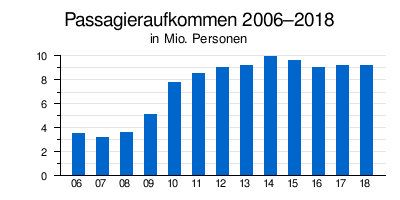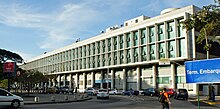Rio de Janeiro-Santos Dumont Airport
| Aeroporto Santos Dumont | |
|---|---|

|
|
| Characteristics | |
| ICAO code | SBRJ |
| IATA code | SDU |
| Coordinates | |
| Height above MSL | 3 m (10 ft ) |
| Transport links | |
| Distance from the city center | 4 km east of Rio de Janeiro |
| Local transport | VLT Carioca Linha 1 |
| Basic data | |
| opening | 1944 |
| operator | Infraero / Air Force |
| surface | 83 ha |
| Terminals | 1 |
| Passengers | 9,206,059 (2018) |
| Air freight | 6,680 t (2018) |
| Flight movements |
100,144 (2018) |
| Capacity ( PAX per year) |
9.9 million |
| Runways | |
| 02R / 20L | 1323 m × 42 m asphalt |
| 02L / 20R | 1260 m × 30 m asphalt |
The Aeroporto Santos Dumont is one of two airports in the Brazilian city of Rio de Janeiro . It is used for intra-Brazilian traffic.
location
The airport is located on a headland in the immediate vicinity of downtown Rio de Janeiro in the sub-prefecture Centro e Centro Histórico .
The airport is known for the demanding approach to runway 02. A normal approach on an ILS glide path is not possible because the landmark of Rio de Janeiro, the four hundred meter high granite rock of the Sugar Loaf, is less than four kilometers from the runway. The pilots must therefore fly as close as possible to the rocky chain in the counter approach, then fly a tight left turn and land at the airport a few seconds later. This approach can be roughly compared with that of runway 08 at Innsbruck Airport .
history
The airport was built between 1937 and 1944. It was planned by the two architects Marcelo and Milton Roberto . It is named after the Brazilian aviation pioneer Alberto Santos-Dumont .
The new tram system in Rio de Janeiro has served the airport since 2016 .
Airport facilities
Start-and runway
The existing runway 02R / 20L has a length of 1323 meters. To increase the capacity, the second runway 02L / 20R was built with a length of 1260 meters.
terminal
The passenger terminal is characterized by its long, strictly gridded glass facade. Vertical concrete slats serve as protection from the sun. Both the arrival and departure terminals are located on the ground floor. The first floor is reserved for administration, shops and restaurants.
Airlines and Destinations
From this airport the airlift Rio de Janeiro-São Paulo to the inner-city airport Congonhas in São Paulo is served, sometimes every 10 minutes. There are up to 80 connections from all airlines on this section every day. The airport is used by the Brazilian airlines Azul Linhas Aéreas , Gol Linhas Aéreas , LATAM Airlines Brasil and Passaredo Linhas Aéreas .
Traffic figures

| year | Passenger volume | Air freight ( tons ) (with airmail ) |
Flight movements | |||
|---|---|---|---|---|---|---|
| 2018 | 9,206,059 |
-0.44%
|
6,680 |
+ 91.35%
|
100.144 |
-1.88%
|
| 2017 | 9,247,185 |
+ 2.00%
|
3,491 |
+39.42%
|
102.067 |
-3.41%
|
| 2016 | 9,065,905 |
-5.74%
|
2,504 |
-13.42%
|
105,671 |
-12.33%
|
| 2015 | 9,618,197 |
-3.09%
|
2,892 |
-43.17%
|
120,538 |
-4.18%
|
| 2014 | 9,924,977 |
+ 7.83%
|
5,089 |
-42.35%
|
125,798 |
-1.20%
|
| 2013 | 9.204.603 |
+ 2.24%
|
8,828 |
+29.96%
|
127,328 |
-5.94%
|
| 2012 | 9,002,863 |
+ 5.73%
|
6,793 |
+ 16.66%
|
135,373 |
+ 4.43%
|
| 2011 | 8,515,021 |
+ 8.85%
|
5,823 |
+ 71.21%
|
129,629 |
+ 2.46%
|
| 2010 | 7,822,848 |
+53.40%
|
3,401 |
-4.57%
|
126,515 |
+ 30.33%
|
| 2009 | 5,099,643 |
+ 40.53%
|
3,564 |
+ 42.05%
|
97.075 |
+ 35.72%
|
| 2008 | 3,628,766 |
+ 12.89%
|
2,509 |
-8.20%
|
71,527 |
+ 8.89%
|
| 2007 | 3,214,415 |
-9.53%
|
2,733 |
-23.88%
|
65,689 |
+1.68%
|
| 2006 | 3,553,177 | 3,590 | 64,603 | |||
- ↑ From 2010, transit freight will also be taken into account.
Incidents
- On December 23, 1946, an Avro York of the Argentine Flota Aérea Mercante Argentina (FAMA) ( aircraft registration LV-XIG) coming from Natal collided with the 990 m high mountain Pico de Papagaio while approaching the airport of Rio de Janeiro-Santos Dumont . All 21 inmates were killed.
- On September 12, 1954, the pilots of a Douglas DC-3 / C-47A of the Brazilian Cruzeiro do Sul (PP-CDJ) returned to the departure airport of Rio de Janeiro-Santos Dumont when the weather conditions at the destination airport of Sao Paulo-Congonhas fell below the minimum were. Due to severe vibrations in engine 1 (left), it was shut down. The plane was too high on the final approach; the attempted go-around , the aircraft fell into a descent and smote the waters of Guanabara Bay on. In this accident 6 of the 21 passengers were killed, all 4 crew members and the other 15 passengers survived.
- On January 11, 1958, a Fairchild C-82A package of Cruzeiro do Sul (PP-CEH) crashed on a training flight at Rio de Janeiro-Santos Dumont Airport ( Brazil ). With blind flight covers on the windshields, the machine flew too low, collided with a barrier and crashed into Guanabara Bay . All three crew members, the only occupants, survived.
- On December 30, 1958, a Saab Scandia of VASP (Viação Aérea São Paulo) (PP-SQE) took off from Rio de Janeiro-Santos Dumont Airport for a flight to São Paulo-Congonhas Airport . During take-off, engine no. 1 (left) failed at a height of 50 meters. The attempt to return resulted in a stall ; the plane crashed in Guanabara Bay . 21 of the 37 inmates were killed.
- On February 25, 1960, a Douglas DC-3 / C-47A-25-DK of the Brazilian REAL (PP-AXD) collided with a Douglas DC-6 / R6D-1 of the United on approach to Rio de Janeiro-Santos Dumont airport States Navy (Bu 131582) . Both machines crashed, killing 61 people: all 26 people on board the DC-3 and 35 of 38 in the DC-6 died.
- On August 20, 1965, the pilots of a Convair CV-240-0 of the Brazilian Cruzeiro do Sul (PP-CFD) returned to the departure airport in Rio de Janeiro-Santos Dumont after an engine failed soon after take-off. When landing, the aircraft came off the runway to the left, causing the left main landing gear to collapse. All 33 occupants, 5 crew members and 28 passengers survived the total write-off.
- On August 23, 1973 crashed NAMC YS-11 of VASP (PP-SMJ) after a failed rejected takeoff from the airport in Rio de Janeiro Santos Dumont in the Guanabara Bay . At the last moment the master tried to stop the machine, which could not be braked in time, by retracting the landing gear before falling into the water (see also VASP flight 012 ) .
Web links
- Official website (Portuguese)
- Official website of the operating company Infraero (Portuguese)
- Airport data on World Aero Data ( 2006 )
- Airport data in the Aviation Safety Network (English)
Individual evidence
- ↑ a b c d Características. Infraero.gov.br , accessed October 23, 2018 (Portuguese).
- ↑ a b c d e Estatísticas. Infraero.gov.br , accessed August 16, 2019 (Portuguese).
- ↑ http://www.aeroportosantosdumont.net/guia-aeroporto-santos-dumont
- ↑ Companhias Aéreas. Infraero.gov.br , accessed August 16, 2019 (Portuguese).
- ^ Accident report Avro York LV-XIG , Aviation Safety Network (English), accessed on November 29, 2015.
- ^ Accident report DC-3 PP-CDJ , Aviation Safety Network (English), accessed on August 5, 2020.
- ^ Accident report Fairchild C-82 PP-CEH , Aviation Safety Network (English), accessed on August 3, 2020.
- ↑ Accident report SAAB Scandia PP-SQE , Aviation Safety Network (English), accessed on August 3, 2019.
- ↑ ICAO Aircraft Accident Digest No. 10 Volume II, Circular 59-AN / 54 (English), p. 246.
- ^ Accident report collision Rio, February 25, 1960: DC-3 PP-AXD , Aviation Safety Network (English), accessed on February 14, 2019.
- ^ Accident report collision Rio, February 25, 1960: DC-6 Bu 131582 , Aviation Safety Network (English), accessed on February 14, 2019.
- ^ Accident report CV-240 PP-CFD , Aviation Safety Network (English), accessed on August 3, 2020.
- ^ Accident report NAMC YS-11 PP-SMJ , Aviation Safety Network (English), accessed on August 3, 2020.
